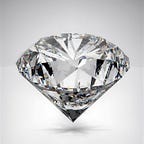VARIETIES OF DIAMONDS Color
VARIETIES OF DIAMONDS Color
FANCY STONES
Diamonds occur in all shades, from deep yellow to pure white and jet black, from deep brown to light cinnamon, also green, blue, pink, yellow, orange, and opaque.
Both in Kimberley and De Beers the blue ground on the west side is poorer in diamonds than the blue ground in other parts of the mines. The diamonds from the west side also differ somewhat from those in other parts of the same mine.
The diamonds from each mine have a distinctive character, and so uniform are the characteristics that an experienced buyer can tell at once the locality of any particular parcel of stones. An isolated stone may, of course, be found occasionally in any one mine which is characteristic of some other source of production, but this is the exception to the general rule.
There is a great similarity between the produce of the De Beers and Kimberley mines. A day’s wash from either of these mines could be distinguished from each other, but not so easily the majority of the individual stones.
The Kimberley Mine produces a small percentage of white crystals, octahedral in shape, is noted for its large macles, and, in common with the De Beers Mine, it also yields a large percentage of coloured and large yellow diamonds.
The De Beers Mine produces a comparatively small percentage of really white diamonds, but is noted for its fine silvery capes.
The Dutoitspan Mine is noted for its fine white cleavages, silver capes, large yellows, and an exceptional proportion of large stones generally. It also produces a small proportion of fine white, octahedral-shaped crystals and a comparatively small proportion of diamonds below 0.2 of a carat in size.
The Bultfontein Mine produces a very large percentage of white diamonds, mostly octahedral in shape and generally small in size. It produces very few coloured stones, but a larger percentage of flawed and spotted stones than any other mine. Even the apparently pure stones from this mine frequently develop flaws in cutting, which in the rough were imperceptible to the naked eye.
The Wesselton Mine diamonds are noted for an abnormally large percentage of octahedral stones, a large proportion of which are free from flaws. White and brown stones predominate in this mine; there is almost an entire absence of the ordinary yellow, but very fine golden-coloured fancy stones are unearthed occasionally, invariably in the form of cleavage, and hardly ever exceeding 2 carats each in weight.
For “golden fancies” this mine is unrivalled. Wesselton diamonds are easily distinguished from the produce of every other mine by a decided gloss common to them.
Wesselton produces more stones of 10 carats each and over than Bultfontein, but comparatively few large stones of over 50 carats each. It produces a very large percentage of small diamonds under 0:2 of a carat. With Bultfontein it shares the distinction of yielding cubical stones occasionally. It also produces a small percentage of blue-whites. The Frank Smith Mine produces very fine white diamonds, fairly regular in shape, mostly octahedral, and hardly any coloured stones. Many of the stones are grooved at the edges.
The Kamfersdam Mine yields diamonds of very inferior quality, dark brown being the predominating colour, and even the majority of the better-class stones from this mine are faintly tinged with brown.
The Kimberley West, formerly known as Theron’s Mine, situated about 30 miles due west of Kimberley, yields a very small percentage of blue-whites, fine “silver capes,” and a large proportion of brown diamonds, somewhat better in quality than Kamfersdam and more regular in shape. The diamonds from this mine present a distinctly “alluvial” appearance, but they are nevertheless distinctive in character from river diamonds and much inferior in quality.
The diamonds from the Leicester Mine are of a distinctive character; they are very much grooved, extremely bad shapes for cutting, and many of the stones are cross-grained.
The Newlands Mine, West Griqualand, about 40 miles north-west of Kimberley, is interesting on account of the occurrence of diamond in what the Reverend Professor Bonney considers to be its true matrix. The workmen occasionally come across well-rounded, boulder-like masses of eclogite, a rather coarsely crystalline rock, sometimes more than a foot in diameter. Some of these boulders have diamonds imbedded in them. One piece examined by Professor Bonney measured approximately 4 inches by 3 inches by 2 inches, and appeared to have been broken off a larger eclogite boulder. In it were seen ten diamonds, mostly well-crystallised octahedra, perfectly colourless, with brilliant lustre, four of them being comprised within a space of a quarter of an inch square. All these diamonds were on the surface.
Probably others would have been found inside, but it was not considered desirable to destroy the specimen by breaking it up. It is now in the Natural History Museum, having been presented by the Directors of the Newlands Mine.
Eclogite has been found in other diamond mines, but I am not aware that diamonds have been found imbedded in it except in the Newlands Mine.
Stones from Jagersfontein, in the Orange River Colony, display great purity of colour and brilliancy, and they have the so-called “steely” lustre characteristic of old Indian gems.
Source : DIAMONDS BY SIR WILLIAM CROOKES
